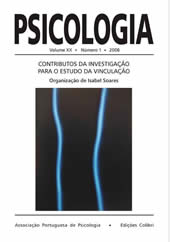Mothers' Internal Model of attachment and Their Children's Secure Base Behaviour in an adopted sample
DOI:
https://doi.org/10.17575/rpsicol.v20i1.376Keywords:
-Abstract
Studying the quality of attachment in adopted children is of greta importance for the attachment theory allowing for an evaluation of the quality of attachment and its development in families that do not have the same genetic information nor do they share a familial history. The objectives of the current study are to evaluate if the child’s age at the time of adoption affects the quality of attachment established within the new family and if a relationship between the mother’s interal working model and the adopted child’s secure-base behaviour exists. The AQS (Waters, 1987) was used to examine the characterization of the quality of the mother-child attachment relationship and the Maternal Narratives (H. Waters & Rodriges-Doolabh, 2001)were used to access the mother’s internal working model. No significant correlation as found between the child’s age and the qualit of attachment suggesting that thhe child can establish meaningful relationships at 2, 3 and 4 years of age, thus stressing the importance of the presence of maternal sensitivity in the development of affectional ties. The results show that the quality of the scripts of maternal secure base is associated with the criterion of security in children. Thus, These results go hand in hand with Ainsworth’s findings which emphasize the importance of maternal sensitivity in the construction of the attachment theory, “transgenerationality”, where the mother’s internal working model mediates the quality of childcare and interactions established with the child.


